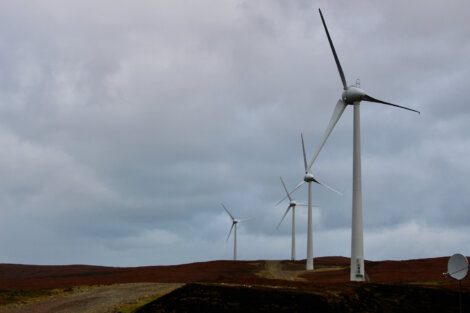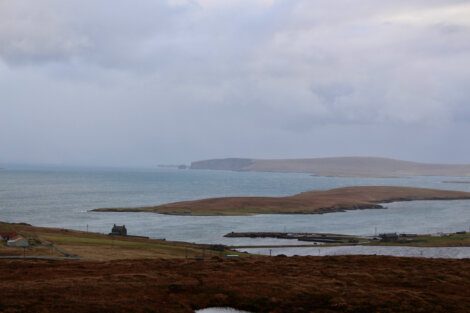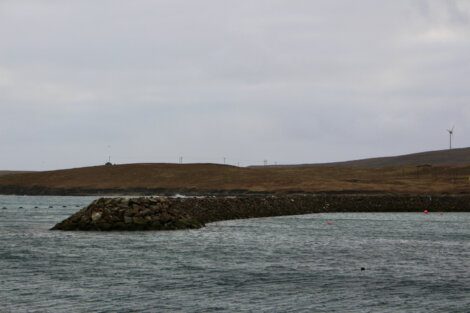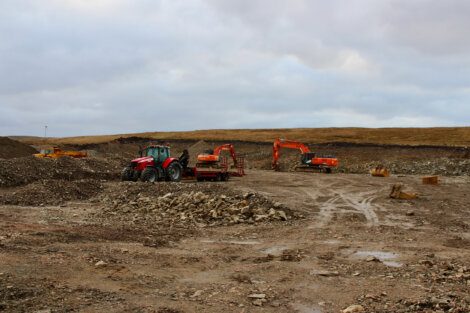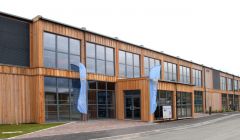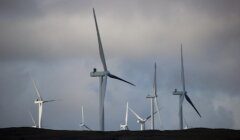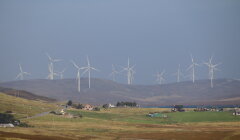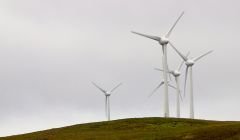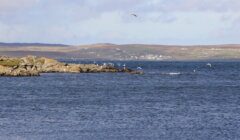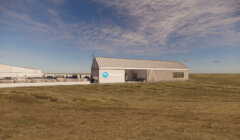Features / Five years of wind energy in North Yell as new marina prepares to open
North Yell Development Council launched its five-turbine Garth wind farm in 2017 and plenty is on the horizon for go-ahead group
IT WAS around five years ago when the skyline of North Yell changed.
With Ann Jessie, Eel, Eliza, Excelsior and Undaunted standing over 40 metres tall, they have an envious view over the northerly isle and beyond.
The Enercon wind turbines, launched at Garth by North Yell Development Council in April 2017, are poignantly named after the fishing boats which were lost in the deadly Gloup storm disaster of 1881.
Garnering goodwill, the profits are put back in the community, with small grants already distributed to local groups like the playgroup and Up Helly Aa – while £400,000 has been invested in a new £3 million marina and upgraded business park not too far from the wind farm.
Loans taken out to pay for the turbines are not paid off in full yet – there’s still a number of years to go – but the wind farm has been heralded as a success.
North Yell Development Council director Andrew Nisbet has been a driving force behind the Garth wind farm, which took years to crawl through the process from initial plans to connecting to the local grid.
“The first two years we were building up funds to build up a reserve, and we weren’t able to take a profit,” Nisbet reflects as he drives up the access track to the wind farm, “but the last couple of years we’ve been able to take a profit and put that into community schemes, mainly the marina/business park that we’re working on at the moment.”
As Shetland News visits, one of the turbines has perhaps succumbed to a bout of stage fright and developed a fault. But slightly more worryingly one of the other turbines has been waiting for weeks for an engineer to bring it back to full health.
Become a member of Shetland News
The last couple of years have been difficult, with the Covid pandemic and travel restrictions causing delays to maintenance – “it’s taken weeks, sometimes months” – which has had a knock-on effect to income.
Fittingly it is a blustery late January day, with the blades of those turbines in fine fettle spinning hypnotically whilst being surprisingly quiet.
If you manage to remove your gaze from the whirly twirl up and above then the views out across the rolling hills of Yell, and over to the sea, are pretty inspiring, even in murky weather.
Alongside the five turbines is a substation, where the power joins the local grid. There’s a couple of fancy looking pieces of kit enabling both the wind farm engineers – back in Germany – and Lerwick Power Station to control things remotely.
The latter is involved to allow the right levels of supply onto the Shetland network – a grid which also given power by the five-turbine Burradale wind farm on the outskirts of Lerwick.
Inside the Garth turbines there are control boxes detailing some important facts and figures; at the time the wind speed was 16.5 metres a second, generating 904kW of power.
Since being switched on trusty Eliza, for example, has generated more than 13,000MWh of electrical energy.
These five wind turbines have been purring along gently while the much larger, and divisive, Viking Energy development on the central Shetland mainland began construction last year.
And elsewhere in Yell plans rumble on for the 18-turbine Energy Isles wind farm, while in the south of the island consent has already been granted for 17 turbines in the Beaw Field development.
The community payback for SSE’s 103-turbine Viking wind farm, despite being more than £2 million a year once live, is diluted compared to what was first mooted many moons ago to the chagrin of some, and plenty of the power will be headed south through a new subsea cable.
By comparison, Garth is relatively tiny. Energy Isles’ turbines are planned to be 180m from bottom to the top of the blade tips, and Viking will be 155m, which is around double those in North Yell.
And with all profits being reinvested locally there is certainly goodwill in the community. “We didn’t get any objections when we first thought about it in 2003,” Nisbet says.
“I think a lot of that is because it is community owned. People know that the benefit is going to be spent locally and they are more inclined to be in favour.”
Not too far away at the busy Cullivoe Pier and you can already see the benefits of Garth wind farm paying off.
A large breakwater has been formed for a new marina, built by North Yell Development Council, which will offer 28 berths and is set to provide a new home for commercial boats once open later this year.
It is expected that there will be five commercial sea angling or boats doing sea tours, a charter yacht, 12 small fishing boats and then five berths for visiting yachts, Nisbet explains.
It sits near to the ongoing construction of an expanded business park, which has proved extremely popular and is set to play host to companies like Cooke Aquaculture.
The injection of £400,000 into the project has helped the development group to lever in significant funding from organisations like Scottish Land Fund, Highlands and Islands Enterprise, the Scottish Government, Marine Scotland and Shetland Islands Council.
“Each of the sea angling boats can take eight people out each day, so that adds to quite a lot of tourists over a season,” Nisbet adds. “So it’s a major boost to the area, the tourists that the industry is bringing in now.”
The new marina sits alongside the hubbub of activity at the Cullivoe Pier, which is an important centre for fishing and aquaculture. Around six trailers of salmon leave every day, sometimes up to nine, with whitefish and shellfish boats coming into the harbour too to make it one of the busier ports in the UK.
The pier also acts as a base for tidal energy company Nova Innovation, which has a handful of turbines in nearby waters.
To get to the pier, though, you have to travel along the now-infamous Cullivoe road, which is set to be revamped by the council in coming years.
Parts of it are like a patchwork quilt, where temporary upgrades have been plastered onto the road, and the width is risky enough for a van let alone a salmon-laden trailer.
The road’s upgrade has been a long time coming for locals, and materials for the new marina – those which were not re-used from excavations at the business park – had to be taken by boat to avoid trucks causing any further wear and tear.
“It’s holding up all developments at the moment,” Nisbet said.
“People are being stopped from building even an agricultural shed, because of the worries about the road failing and if it failed, it would cause a problem with the salmon. Because the salmon goes to the factory in Mid Yell, and it employs around 50 people, so the whole thing is quite important.”
Nisbet says the North Yell development group was set up many decades ago to raise cash for the Cullivoe pier after the Second World War.
It has grown to feature 69 members, and more than ten directors who are elected each year at the development council’s AGM. Having overseen a wind farm and also creating a new marina and expanded business park, it is certainly comes across as a go-ahead development group.
This is especially vital for an island which, Nisbet says, is experiencing the “slow decline” of depopulation. More jobs for graduates and building a tunnel to Yell instead of relying on a 20-minute ferry trip from Toft would help, the development director reckons.
But what is cast in stone is that after another five years of Ann Jessie, Eel, Eliza, Excelsior and Undaunted spinning, North Yell will have a new marina, hopefully bringing in new tourism, and an even busier business estate.
It is a first-rate example of self-sufficiency for a section of an island with a population of only around 200.
You can look beyond the turbines and multi-million pound projects, though, for a heart-warming example of the development council looking out for its community.
Shortly after Covid-19 effectively shut down society, the group paid for nearly 100 care packages for local residents – including items such as cleaning products and a voucher for the local shop – out of profits from the wind farm.
“Just to say thank you so much for our pack and voucher what an amazing community we live in,” one person wrote on Facebook after receiving their bag. “It brought a tear to my eye.”
Become a member of Shetland News
Shetland News is asking its readers to consider paying for membership to get additional perks:
- Removal of third-party ads;
- Bookmark posts to read later;
- Exclusive curated weekly newsletter;
- Hide membership messages;
- Comments open for discussion.
If you appreciate what we do and feel strongly about impartial local journalism, then please become a member of Shetland News by either making a single payment, or setting up a monthly, quarterly or yearly subscription.






